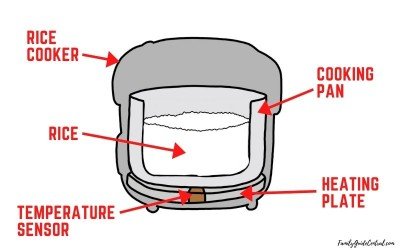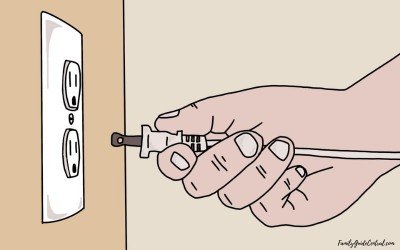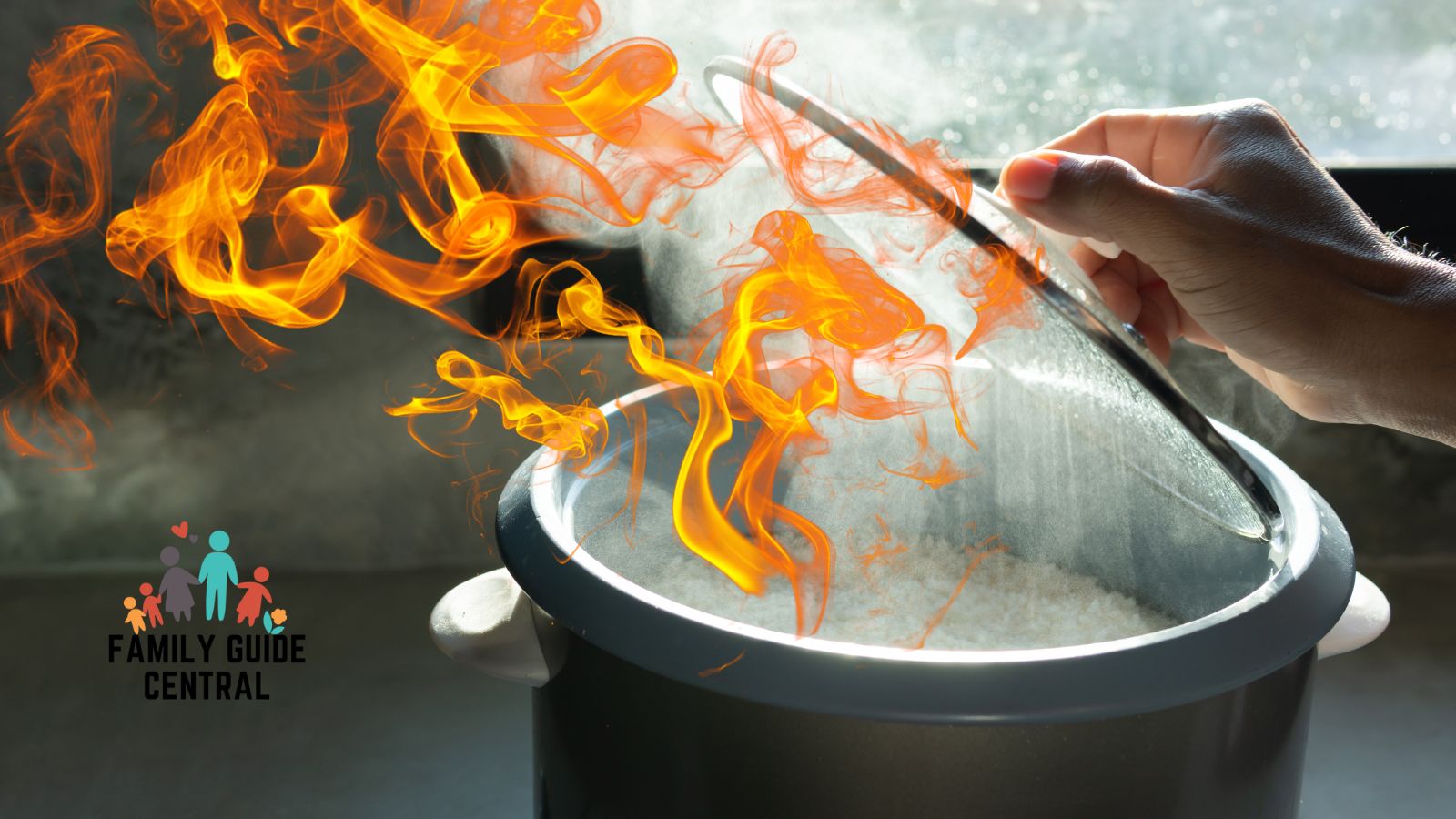Can Rice Cookers Catch Fire and Explode? (Pro Tips on Prevention and Putting Out the Fire)
Rice cookers are a staple in most kitchens. They’re convenient, easy to use, and can make any meal better. But what do you do if your rice cooker catches fire?
Here’s how to prevent it from happening—and what to do if it does happen anyway!
Can rice cookers catch fire and explode?
Rice cookers can catch fire or explode, but this is rare and usually due to misuse or faulty equipment. Rice cookers are designed with safety features to prevent such incidents.
But there are still things that can increase the risk of a malfunction or fire, like overfilling the cooker, putting it on an unstable or flammable surface, using a damaged cooker, or leaving it alone.
Rice cookers use heating plates to rapidly heat up the cooking pan. This causes a massive amount of pressure to quickly build up inside rice cookers. If a rice cooker malfunctioned and couldn’t release this high pressure, then the rice cooker could either overheat, catch fire, or even explode.
Follow the directions, use a stable surface, don’t fill it too much, and don’t leave it alone to reduce the risk.
How to put out a fire in a rice cooker
- Take an appropriate fire extinguisher that is rated for Class A, B, and C fires, which includes extinguishers with ABC ratings.
- Pull the safety pin or painting from the extinguisher.
- Walk up to the rice cooker and assess the situation, making sure you are standing on a stable surface and away from any potential hazards.
- Check the floor to make sure it is not wet or slippery, as this could cause you to slip or fall.
- Open the door of the rice cooker to assess the fire and identify the source.
- Back up a few steps to create a safe distance from the rice cooker and stay low to avoid inhaling any smoke or fumes.
- Aim the nozzle of the extinguisher towards the base of the opening of the rice cooker.
- Spray the extinguisher towards the pot wall of the cooker to bounce it off and onto the fire.
- Avoid spraying the extinguisher directly into the pan or pot that is on fire.
- Keep a safe distance and monitor the rice cooker in case the fire reignites, so you can hit it again with the extinguisher.
- Back away from the rice cooker and assess the situation to ensure it is safe.
- Call 911 or the emergency services to have the fire department respond to the situation.
- Ensure that everyone in the house is safe and that the premises are secure.
What can cause a rice cooker to catch fire or explode?
Even with the standard safety precautions built into rice cookers, there’s still the possibility of a fire or explosion.
This can be due to the blockage of the steam opening, malfunction of the temperature sensor, or any number of electrical fluctuations.
When steam forms rapidly inside a closed container, it begins to create pressure. As the inside of the chamber continues to heat up the water, more steam begins to form. Thus, this will create even more pressure that needs to be released somewhere.
All typical rice cookers are built with an outlet that allows steam to escape, thereby relieving this pressure. If the pressure were to continue to grow unimpeded, there’s a very likely chance of an explosion.
The temperature sensor is the part of the rice cooker that tells the heating plate when to stop heating. Simply put, if this sensor can no longer do its job, then the heating plate will continue to heat until the rice burns and eventually starts a fire.
Another factor to consider is the possibility of an electrical malfunction. Whether it’s due to the rice cooker itself or the outlet it’s drawing power from, there’s a possibility of sparks and short circuits. This isn’t specific to rice cookers, because all electronic devices have this potential. Electrical disasters often lead to fires.
Check out our top picks for the safest rice cookers

- Versatile cooking options
- User-friendly digital controls
- Nutrient-rich meals with steam function
- Programmable delay timer up to 15 hours
- Compact size with accessories included

- Induction rice cooker and warmer
- Multi-menu cooking functions
- Automatic keep warm feature
- Healthy cooking options available
- Convenient delay timer included
How does a rice cooker work?
You may be surprised to know that rice cookers have not fundamentally changed much since the early versions.
Today, we have rice cookers with customizable buttons pre-built for several types of rice. We have rice cookers that we can control with our smartphones. We even have rice cookers that can actually sense how much water was added and adjusts themselves to make the perfect rice.
Nevertheless, they all hold on to the same basic components of heating plates, increasing pressure and signals of when to shut off.

When you place rice and water into a metal bowl, that bowl goes into the rice cooker on top of a heating element. That heating element will rapidly begin to heat up the rice and water causing the water to boil out.
Water boils at 100 °C, so once this happens, the environment inside the rice cooker begins to build up a lot of pressure.
All rice cookers will have a hole or an opening that will help regulate the pressure releasing the steam. What you might find surprising is that when water boils, water molecules are moving rapidly trying to cool themselves off. This, in turn, keeps the temperature inside the chamber from going too much above 100 °C.
However, once all the water evaporates out through the hole, heat is no longer regulated by the water and so the temperature could potentially rise even further.
Fortunately, rice cookers have internal temperature sensors that signal to turn off the heating plate and enter warming mode once this temperature is reached.
What are the other dangers of using a rice cooker?
Heat and pressure
Rice cookers use high heat and pressure to cook rice, which can cause the cooker to explode or release steam, leading to serious injuries.
Use the correct amount of water and rice, and avoid overfilling the cooker. Never open the lid of a hot rice cooker, as it can release steam and cause burns. Use oven mitts or tongs when handling the cooker or its contents.
Burns from steam
Steam can escape from the rice cooker and cause burns to the skin.
Keep your face and hands away from the steam release vent while the cooker is in use. Use oven mitts or tongs to remove the lid of the cooker and handle the contents. Let the rice cooker cool down before taking out the inner pot or touching the outside.
Material burns
Rice cookers can cause fires if placed on flammable surfaces or near flammable materials.
Keep the rice cooker away from curtains, paper, plastic, and other flammable materials. Place the cooker on a stable and non-flammable surface. Never leave the cooker unattended while in use.
Appliance malfunction
Rice cookers can malfunction and cause electrical hazards or fires.
Regularly clean the cooker to prevent buildup and ensure proper functioning. Inspect the cord and plug for any damages before use. Follow the manufacturer’s instructions for proper use and maintenance.
Electrical hazards
Rice cookers run on electricity and can cause electrical hazards if not used properly.
Always unplug the rice cooker before cleaning or handling. Avoid using the cooker near water or other liquids. Do not use a damaged or frayed cord or plug.
Appliance fires
Rice cookers can catch fire and cause damage to property or harm to people. Do not leave the cooker unattended while in use.
Avoid overfilling the cooker with water or rice. Use the cooker on a stable and non-flammable surface. Have a working fire extinguisher nearby in case of an emergency.
Ways to prevent my rice cooker from catching fire
- Use the correct amount of water and rice: Overfilling the rice cooker can cause it to boil over and create a potential fire hazard. Make sure to use the correct ratio of water and rice as stated in the manufacturer’s instructions.
- Place the rice cooker on a stable and non-flammable surface: Keep the rice cooker on a flat and stable surface that is not flammable, such as a kitchen counter made of stone or tile. Avoid placing the cooker near curtains, paper, plastics, or other flammable materials.
- Use a surge protector: Consider using a surge protector to prevent electrical hazards. This can help protect the rice cooker from power surges or voltage spikes that can cause it to overheat or catch fire.
- Use an undamaged and properly functioning rice cooker: A damaged or faulty rice cooker can overheat or malfunction, causing it to catch fire. Make sure to inspect the rice cooker for any damages before each use and only use it if it is in good working condition.
- Never leave the rice cooker unattended: Leaving the rice cooker unattended can increase the risk of overheating or malfunction. Always keep an eye on the rice cooker while it is in use.
- Follow the manufacturer’s instructions: The manufacturer’s instructions provide specific guidelines on how to use the rice cooker safely. Make sure to read and follow the instructions carefully, including cleaning and maintenance guidelines.
- Use a timer: Set a timer to keep track of how long the rice has been cooking. This can help prevent the rice from overcooking and boiling over, which can cause a fire hazard.
- Keep the rice cooker clean: Regularly clean the rice cooker, especially the heating element and the inner pot. This can prevent the buildup of dirt, grime, or leftover food that can cause the cooker to malfunction or overheat.
How can I tell if my rice cooker is overheating?
Unusual smell
If you smell an unusual burning odor or a plastic smell coming from your rice cooker, it may be overheating.
Hot exterior
If the exterior of the rice cooker is hot to the touch, even when it’s not in use or when the rice is already cooked, it may be overheating.
Uneven cooking
If the rice is cooked unevenly or takes longer than usual to cook, it could be a sign that the rice cooker is overheating.
Automatic shut-off
Many rice cookers have an automatic shut-off feature that turns off the cooker when the rice is cooked. If the rice cooker doesn’t shut off automatically, it could overheat.
Sounds and noises
If you hear unusual sounds, such as popping or hissing, coming from the rice cooker, it could be overheating.
Can you overcook in a rice cooker?
Yes, it is possible to overcook rice in a rice cooker if you leave it in the cooker for too long. Overcooked rice can become mushy, sticky, or dry and lose its texture and flavor.
To avoid overcooking, use the correct amount of water and rice, and avoid leaving the rice in the cooker for too long.
Is it normal for a rice cooker to smoke?
No, it is not normal for a rice cooker to smoke. Smoking from a rice cooker can be a sign of a malfunction or overheating, which can be dangerous.
If you see smoke coming from your rice cooker, immediately unplug it and let it cool down before inspecting it for any damages or malfunctions.
If you find any damage, do not use the rice cooker and contact the manufacturer for assistance.
What are the safety features built into a rice cooker?
Automatic shut-off
Most rice cookers have an automatic shut-off feature that turns off the cooker when the rice is cooked. This helps prevent overcooking and overheating.
Thermal sensors
Rice cookers are made with sensors that can tell how hot the rice is and how hot the cooker is. If the temperature gets too high, the cooker will automatically shut off.
Pressure relief valve
Some rice cookers have a pressure relief valve that lets out any extra pressure that builds up inside. This keeps the pressure from getting too high and possibly causing an explosion.
Non-stick coating
A non-stick coating on the inside of the pot of many rice cookers keeps the rice from sticking and burning, which can be a fire hazard.
Sturdy handles
Rice cookers usually have sturdy handles to prevent the pot from tipping over and spilling hot rice.
How to safely use a rice cooker
No electrical appliance is free from potential harm and danger. It’s important that we follow a few rules when using devices we aren’t familiar with.

- Read the instructions manual: This is something most people don’t do. I suggest skimming through some of the more pertinent information in the manual. This manual provides almost everything you need to know about assembling, and dissembling, and cleaning the rice cooker properly.
- Know the voltage requirements: This is very important to know. An example of an issue you may run into is if you purchased a unit built specifically for one region that has a voltage standard different from your own. Attempting to use an adapter without understanding the requirements or limits is potentially disastrous. This may lead to an electrical fire.
- Store and operate it in a safe place: Place the rice cooker in a place where it is safe from its environment and where you are safe from it. You don’t want to store it close to any flammable objects. These rice cookers get really hot and should be kept far away from objects that are easily flammable.
- Regularly maintain and clean it: When electronic equipment gets used, it gets dirty. Even when you’ve left it alone for a really long time, it gets dusty. It’s important to make sure you clean vital areas of the rice cooker such as the opening area where the steam comes out. This also keeps the rice cooker clean and sanitary.
- Don’t leave it unattended: The entire notion of having a rice cooker is to leave alone while it’s cooking right? Not exactly, like any heating device, a rice cooker works similar to a stove left on low. Even though it’s less frequent and there are many fail-safes, you shouldn’t be leaving the home right after turning it on to cook. If you must, it’s safer to have it turned off or in warm mode. However, leaving rice on warm for too long can ruin your rice.
- Call the manufacturer about your questions and concerns: Most manufacturing companies have wonderful customer service departments. Large brands often provide lots of information on how their products work and how to properly use, keep, and maintain them.
Are rice cookers safe?
Statistically speaking, there are very few incidents regarding rice cooker explosions reported. In fact, most reports of incidents found that pressure cookers make up most, if not, all of the incidents recorded. Rice cookers have been considered relatively safe. This is due to a couple of safety mechanisms built into a rice cooker.
Rice cookers do build up a lot of pressure. However, this pressure is constantly being relieved thanks to the hole or opening that’s always created in its build. This component’s reason for existence is to regulate the release of steam from the built-up pressure.
This opening is also conveniently part of the cooking process that results in the soft, moist, and delicate texture of rice.
Another fail-safe advantage for rice cookers is that they all contain temperature-sensing units inside that monitor the temperature of the plate. If the plate were to go beyond a certain temperature, the sensor would signal the rice cooker to immediately shut off or go into warming mode.
Other interesting articles:
- How to Easily Protect Your Floors from Dining Table Legs (5 Do’s and 1 Don’t)
- The Best Shape Dining Table for Parties and Large Families (Calculations and Proof!)
- How Many Legs Does a Dining Table Have? (Legs vs Seating Capacity)
- How Long Does It Take to Assemble a Dining Table? (Tips for the Quick and Easy Methods)

